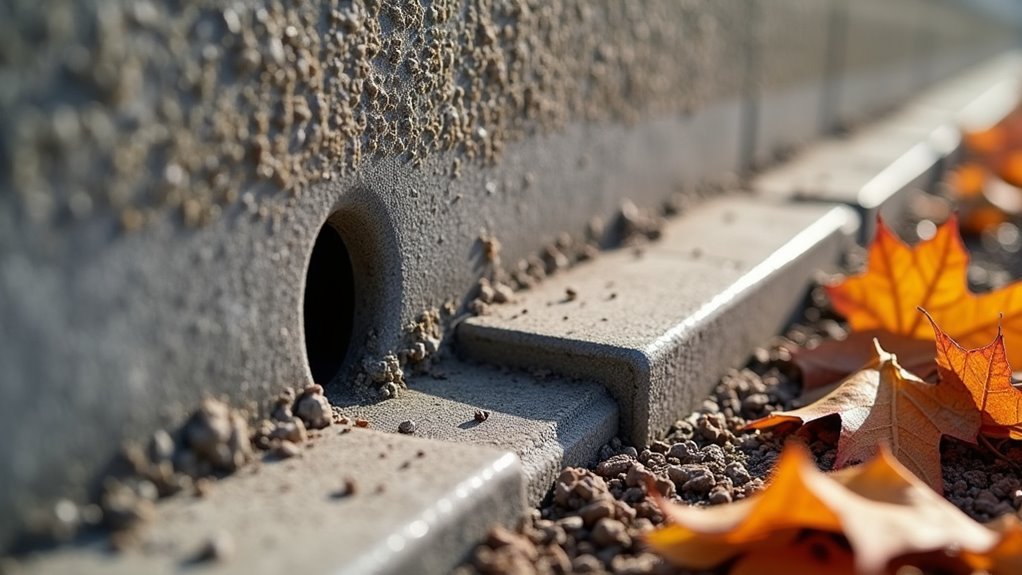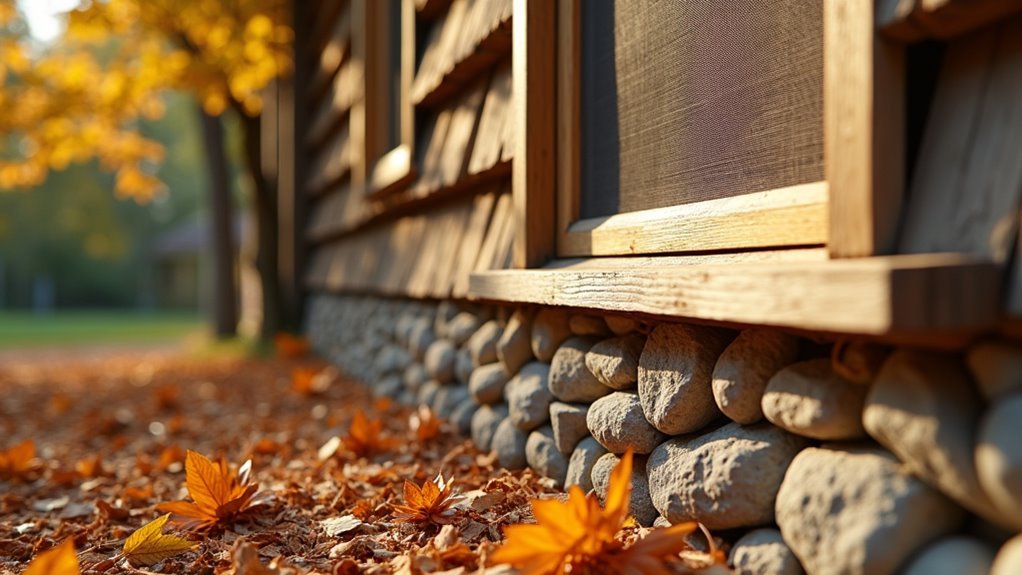You’ll prevent 95% of mouse invasions by implementing seasonal foundation defenses that target entry points when rodents seek shelter. Inspect and seal foundation cracks with caulk or expanding foam, focusing on quarter-inch gaps near utility penetrations. Install hardware cloth over vents, clear debris from your foundation perimeter, and weatherproof basement window wells before freezing temperatures arrive. Schedule professional inspections to catch subtle changes, and maintain proper drainage to eliminate moisture that attracts mice. These extensive strategies will reveal additional protection methods.
Inspect Foundation Cracks and Gaps During Fall Weather Changes

As autumn temperatures begin to drop, mice actively search for warm shelter, making your home’s foundation their primary target for entry.
You’ll need to inspect foundation cracks thoroughly, as even quarter-inch gaps provide sufficient access points. Seasonal weather changes often worsen existing damage, creating new vulnerabilities that developed over summer months.
Walk around your foundation’s perimeter, examining every visible crack and hole. Pay special attention to areas where utilities enter your home, as these spots commonly develop gaps.
Don’t underestimate small openings – mice can squeeze through surprisingly tiny spaces.
Seal discovered cracks immediately using caulk or expandable foam to prevent mice from establishing entry routes.
This proactive approach considerably reduces your risk of mouse infestation during winter while improving your home’s energy efficiency.
Seal Basement Window Wells Before Winter Freeze
You’ll need to thoroughly inspect your basement window wells for any cracks, gaps, or deterioration that could provide entry points for mice seeking winter shelter.
Install durable window well covers to create an additional protective barrier against both pests and harsh weather conditions.
Apply high-quality weatherproof sealant materials like waterproof caulk or expanding foam to seal any identified openings before freezing temperatures make repairs more difficult.
Inspect Window Well Condition
Window wells present one of the most overlooked entry points for mice seeking basement access during colder months. When you inspect the area around your window wells, you’ll need to examine every detail carefully. Look for cracks, gaps, or deterioration in the foundation of your home surrounding these structures. Even small gaps as tiny as 1/4 inch can allow mice entry, making thorough inspection essential for identifying potential entry points.
| Inspection Area | What to Check | Action Required |
|---|---|---|
| Window frames | Cracks, gaps, loose fittings | Seal with weatherproof caulk |
| Well walls | Structural damage, holes | Repair and reinforce |
| Drainage | Standing water, debris buildup | Clean and improve drainage |
| Covers | Secure fit, intact condition | Replace or repair covers |
| Surrounding soil | Settlement, erosion | Grade and compact properly |
Install Protective Well Covers
Once you’ve identified vulnerabilities during your window well inspection, proper protective well covers become your next line of defense against mouse intrusion.
These covers effectively seal basement window wells before winter freeze, preventing mice from exploiting dark, sheltered spaces near your home’s foundation. Choose durable materials that withstand harsh winter weather while blocking rodent entry points completely.
Install covers that fit snugly over each window well, ensuring no gaps remain for mice to squeeze through. Even small openings can escalate into a serious mouse problem once temperatures drop.
Quality protective well covers transform vulnerable basement areas into secure barriers.
Remember to inspect your covers regularly throughout winter, removing debris that might compromise their effectiveness and maintaining their integrity against potential rodent invasion.
Apply Weatherproof Sealant Materials
While protective covers form your first barrier, applying weatherproof sealant materials creates an essential secondary defense that blocks even the tiniest gaps mice exploit during winter months.
You’ll need to inspect and repair your basement window wells thoroughly before applying sealant. Look for cracks or openings larger than 1/4 inch around window frames and well structures.
| Sealant Application Focus | Key Requirements |
|---|---|
| Material Quality | Rodent-proof, temperature-resistant |
| Coverage Areas | Corners, edges, frame perimeters |
| Maintenance Schedule | Regular winter inspections |
Choose high-quality sealants that withstand harsh conditions and temperature fluctuations. Apply the material evenly, concentrating on gaps around corners and edges where mice commonly enter. Maintain sealed areas throughout winter to keep your home protected from rodent intrusions.
Clear Drainage Areas Around Foundation Perimeter
You’ll need to eliminate standing water sources that create attractive conditions for mice seeking moisture near your foundation.
Start by installing proper drainage systems that channel water away from your home’s perimeter, preventing the accumulation that draws these pests.
Focus on creating efficient water flow patterns that keep the foundation area dry and less appealing to rodents looking for shelter.
Remove Standing Water Sources
Although mice can survive in various environments, they’re particularly drawn to areas with moisture and standing water near your foundation.
You’ll need to systematically remove standing water sources to create an inhospitable environment for these pests. Start by ensuring your gutters and downspouts channel water away from your foundation rather than allowing pooling around your home’s base.
Regularly inspect and clear drainage ditches and landscaping features to maintain proper water flow throughout your property. Consider installing a French drain or utilizing gravel areas to facilitate better drainage and reduce moisture accumulation.
These proactive drainage improvements greatly decrease the likelihood of attracting rodents, as you’re eliminating the wet conditions that provide them with essential resources and comfortable shelter near your foundation.
Install Proper Drainage Systems
Since moisture control forms the cornerstone of effective rodent prevention, installing proper drainage systems around your foundation perimeter becomes essential for long-term protection.
You’ll want to install proper drainage systems that redirect water at least 6-10 feet from your home’s exterior to prevent pooling that creates ideal rodent habitats.
Focus on maintaining clean gutters and downspouts, as clogged systems cause overflow and increase moisture levels near your foundation.
Consider incorporating French drains or swales to facilitate proper water movement and keep your foundation consistently dry.
Don’t forget to conduct periodic inspections of your drainage components, ensuring they’re debris-free and functioning correctly.
This proactive approach to rodent control maintains a consistently dry environment that naturally deters mice from establishing residence around your home.
Weatherproof Utility Line Penetrations in Foundation Walls

Utility lines entering your foundation create vulnerable spots where mice can squeeze through surprisingly small openings. You’ll need to inspect all utility line penetrations around cables, pipes, and electrical wires regularly, as these gaps often expand over time due to settling and weather changes.
Use weatherproof caulk to seal openings around utility lines, but apply rodent-proof sealants for maximum protection. These specialized products resist chewing and provide long-lasting barriers against persistent mice.
Focus on areas where utilities enter through basement walls, crawl spaces, and ground-level entry points. Schedule seasonal maintenance checks to identify new gaps before they become entry routes, preventing future infestations.
Properly sealed penetrations also improve energy efficiency by blocking drafts and moisture intrusion throughout your home’s foundation.
Install Hardware Cloth Over Foundation Vents and Openings
When mice target your foundation’s vents and openings, hardware cloth provides an impenetrable barrier that maintains essential airflow while blocking unwanted intruders. This galvanized steel mesh withstands gnawing attempts, making it your most durable defense against rodent infiltration.
Cut hardware cloth to fit snugly over each foundation vent and opening, ensuring overlapping edges eliminate potential entry points. Secure the mesh with appropriate fasteners, leaving no gaps or loose edges that mice could exploit. The fine mesh effectively blocks rodents while preserving necessary ventilation.
Inspect your hardware cloth installations regularly for signs of wear, tear, or damage. Maintaining the mesh’s integrity is vital for long-term protection. Replace any compromised sections immediately to keep your foundation secure throughout changing seasons.
Remove Leaf Piles and Debris From Foundation Zones

While hardware cloth blocks entry points at your foundation, accumulated leaves and debris around your home’s perimeter create inviting environments that draw mice closer to these potential access areas.
You’ll need to remove leaf piles regularly from foundation zones, as mice use these materials for building nests. A clean foundation perimeter eliminates the shelter and nesting materials that attract rodents to your home’s base.
Focus on fall cleanup by clearing all organic matter within several feet of your foundation. Remove weeds, brush, and any yard refuse that could provide hiding spots.
Consider establishing a gravel or stone barrier around your foundation’s perimeter. This creates an inhospitable zone that discourages mice from approaching and accessing entry points while making your property less appealing overall.
Apply Expanding Foam to Seasonal Foundation Shifts
Seasonal temperature changes cause foundation materials to expand and contract, creating gaps that weren’t present during your initial rodent-proofing efforts.
You’ll need to address these shifts with expanding foam, which effectively seals these openings and prevents mice from finding new entry points into your home.
Before applying expanding foam, clean and dry the surface around foundation gaps to maximize adhesion. This foam works particularly well for larger openings, as it expands to fill voids completely.
Proper surface preparation ensures expanding foam creates an airtight seal that completely fills foundation voids and prevents rodent entry.
Follow manufacturer instructions carefully, as curing time typically ranges from 8 to 24 hours.
After application, inspect the foam regularly for signs of wear or deterioration. Extreme weather conditions can affect its integrity over time, so maintaining these barriers guarantees your foundation remains secure against rodent intrusion throughout seasonal changes.
Monitor and Seal Concrete Settlement Cracks
You’ll need to recognize different settlement crack patterns in your foundation, as horizontal cracks, stair-step cracks, and vertical fissures each indicate specific structural movements that create mouse entry points.
Choose your sealing materials based on crack size and location—use high-quality polyurethane caulk for hairline cracks and expanding foam for gaps wider than 1/8 inch.
Don’t overlook seemingly minor cracks, since mice can squeeze through openings as small as 1/4 inch and will exploit any foundation weakness.
Identifying Settlement Crack Patterns
As your home’s foundation settles over time, concrete develops characteristic crack patterns that create perfect highways for mice seeking winter shelter. You’ll need to inspect these settlement cracks systematically to identify potential entry points before they become major problems.
| Crack Type | Location | Mouse Risk | Action Required |
|---|---|---|---|
| Hairline | Surface level | Low | Monitor quarterly |
| Diagonal | Corner foundations | Medium | Seal immediately |
| Horizontal | Wall midpoints | High | Professional assessment |
| Vertical | Foundation edges | Medium | Seal and monitor |
| Step | Block foundations | High | Urgent repair needed |
Document each crack’s dimensions and location, as gaps wider than 1/4 inch provide easy access for rodents. Use caulk or expanding foam to seal identified cracks promptly, focusing on foundation areas where mice commonly infiltrate homes during colder months.
Proper Sealing Material Selection
Once you’ve identified concrete settlement cracks requiring attention, selecting the right sealing materials determines your success in blocking mouse entry points. High-quality caulk works effectively for smaller cracks, creating tight seals that prevent rodent access.
For gaps larger than 1/4 inch, combine steel wool with caulk or expandable foam sealant. Steel wool’s rough texture deters mice from gnawing through your repairs.
Choose weatherproof sealants specifically designed for rodent exclusion to enhance long-term protection. These specialized products withstand seasonal temperature changes and moisture better than standard materials.
Remember that proper sealing material selection isn’t just about filling gaps—it’s about creating permanent barriers. Apply foam sealant generously around larger openings, then seal with caulk for maximum effectiveness against potential infestations.
Upgrade Door Sweeps and Foundation-Level Seals
While mice can squeeze through gaps as small as 1/4 inch, upgrading your door sweeps creates an effective barrier against these tiny invaders. A well-fitted sweep prevents rodents from slipping beneath doors, making this upgrade essential for effective pest control.
Foundation-level seals require equal attention in your defense strategy. Inspect your home’s foundation regularly for minor cracks that can serve as entry points. Use caulk or expanding foam to seal these vulnerabilities before mice discover them.
Install durable weather stripping around doors and windows to enhance sealing and reduce drafts. This makes it harder for mice to locate potential access routes into your home.
Maintain these barriers regularly, especially before winter when colder temperatures drive mice indoors seeking warm shelter.
Schedule Professional Foundation Inspection Each Season
Even the most diligent homeowner can miss subtle foundation changes that create new entry points for mice throughout the year. When you schedule professional foundation inspection each season, experts identify new cracks and gaps before they become pathways for rodent intrusion. These professionals spot signs of wear that untrained eyes often overlook, including water damage and erosion that compromise structural integrity.
| Season | Primary Concerns | Inspection Focus | Prevention Benefits | Action Items |
|---|---|---|---|---|
| Spring | Winter damage assessment | Freeze-thaw cracks | Early intervention | Seal new gaps |
| Summer | Heat expansion effects | Foundation settling | Structural stability | Monitor changes |
| Fall | Pre-winter preparation | Weatherproofing | Mice infestation prevention | Upgrade barriers |
| Winter | Moisture intrusion | Ice damage potential | Long-term protection | Emergency repairs |
Regular inspections prevent costly repairs while detecting previous mouse activity through droppings and gnaw marks.
Frequently Asked Questions
What Can I Put Around Foundation to Keep Mice Away?
You can place gravel or stones around your foundation to deter mice from nesting nearby. Also apply peppermint oil, seal cracks with caulk, install mesh over vents, and trim vegetation away.
What Is the Best Defense Against Mice?
You’ll get the best defense by sealing every entry point, no matter how small. Use steel wool and caulk for gaps, inspect regularly, and keep your home’s surroundings clean and clutter-free.
How Do I Stop Mice From Digging Under My Foundation?
You’ll want to create a gravel barrier around your foundation’s base, seal cracks with caulk, install wire mesh perimeters, secure vents with fine screens, and trim landscaping away from your home’s foundation.
How to Mouse Proof Stone Foundation?
You’ll need to seal cracks with steel wool and masonry caulk, clear vegetation from the foundation perimeter, install mesh over vents, and regularly inspect for new gaps after weather changes.
In Summary
You’ll keep mice out of your home by staying proactive with these seasonal foundation defenses. Don’t wait until you spot rodent activity – implement these strategies before cold weather drives mice indoors. Regular maintenance and timely repairs make the difference between a secure foundation and costly infestations. You’re investing in long-term protection when you address foundation vulnerabilities seasonally. Your home’s defense starts at ground level.





Leave a Reply